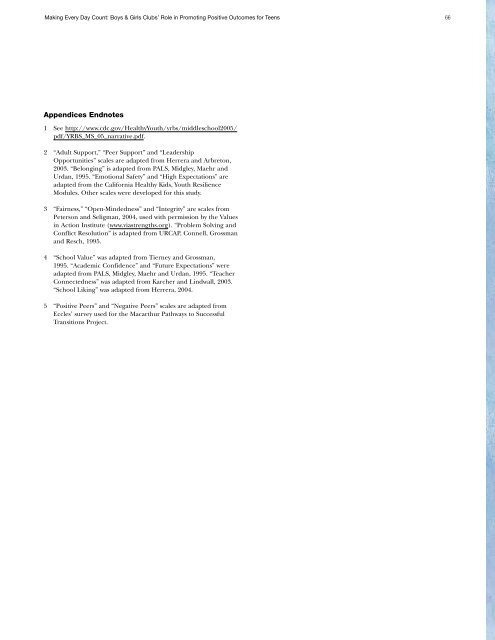Making Every Day Count - Teens
Making Every Day Count - Teens
Making Every Day Count - Teens
Create successful ePaper yourself
Turn your PDF publications into a flip-book with our unique Google optimized e-Paper software.
<strong>Making</strong> <strong>Every</strong> <strong>Day</strong> <strong>Count</strong>: Boys & Girls Clubs’ Role in Promoting Positive Outcomes for <strong>Teens</strong> 66Appendices Endnotes1 See http://www.cdc.gov/HealthyYouth/yrbs/middleschool2005/pdf/YRBS_MS_05_narrative.pdf.2 “Adult Support,” “Peer Support” and “LeadershipOpportunities” scales are adapted from Herrera and Arbreton,2003. “Belonging” is adapted from PALS, Midgley, Maehr andUrdan, 1995. “Emotional Safety” and “High Expectations” areadapted from the California Healthy Kids, Youth ResilienceModules. Other scales were developed for this study.3 “Fairness,” “Open-Mindedness” and “Integrity” are scales fromPeterson and Seligman, 2004, used with permission by the Valuesin Action Institute (www.viastrengths.org). “Problem Solving andConflict Resolution” is adapted from URCAP, Connell, Grossmanand Resch, 1995.4 “School Value” was adapted from Tierney and Grossman,1995. “Academic Confidence” and “Future Expectations” wereadapted from PALS, Midgley, Maehr and Urdan, 1995. “TeacherConnectedness” was adapted from Karcher and Lindwall, 2003.“School Liking” was adapted from Herrera, 2004.5 “Positive Peers” and “Negative Peers” scales are adapted fromEccles’ survey used for the Macarthur Pathways to SuccessfulTransitions Project.


